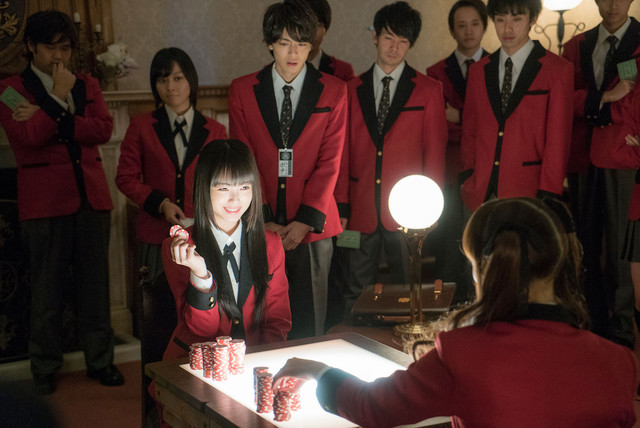Kakegurui Review (TV Show, 2018)
I warned you to stay tuned for this during the Kakegurui anime review last week.
The success of the Kakegurui manga and anime in 2017 led to the production of a 10-episode live action adaptation released in 2018. It's the same story, only told with real life actors and a whole lot less of the disturbing sexualization of teenagers from the cartoon.
Yumeko gambles against Mary in the variant rock-paper-scissors card game while Ryota and the class watch.
Kakegurui is about an elite school ruled by gambling. The student government ranks students based on earnings and donations to the school, and only the top gamblers can keep themselves at the top. The bottom 100 students are treated as house pets, students who must do anything asked of them until they can pay their way out of debt through gambling. A new student, Yumeko, enters the school excited to play any and every game she can with ridiculous stakes. She drags new house pet Ryōta along as her tour guide, forcing him to witness some of the most absurd and depraved gambling you've ever imagined.
The casting in the live action Kakegurui is incredible. The young actors are fully committed to acting as living cartoons. Their body language and facial expressions are rubber-like, bordering on the special effects-enhanced transformation of the gangsters in Who Framed Roger Rabbit?.
Special mention has to go out to Mahiro Takasugi's portrayal of Ryota. In the anime, Ryota is an effective narrator. He gives the audience the basic information they need--those occassional TV reminders of what happened, who is who, and how the rules work--without much of a personality. He's an average teenage boy, a foil to the eccentric personas that dominate gambling in the school.
Ryota serves as a narrator and a dynamic character capable of standing out against Yumeko and the rest of the ensemble in the live action Kakegurui.
In the live action series, you can't take your eyes off of Ryota. Takasugi takes all those awkward teenage moments and amps them up. It's very reminiscent of the acting in Kinji Fukasaku's films, an absurd exaggeration of human insecurity justified by greater social themes at play. The difference is Takasugi does all of this to take a simple narrator and make him a dominating and important presence in a live action cartoon. There's no greater meaning to the character choices other than creating a far more dynamic narrator to follow through this journey.
Indeed, the live action Kakegurui is clearly trying to recreate the anime and that's a great thing. Some of the more brilliant design decisions--a flashing light in an eye, shifts to narration to reveal strategies in a game--really pop in live action. The actors are doing the heavy work when it comes to recreating the movement and tone of the show. The design team elevates it with the post-production manipulation of well-acted scenes to take on animated elements. A bright red flashing eye is far more disturbing on a live actor than it is on a cartoon.
Perhaps the biggest improvement on the anime is the treatment of the house pets. The anime makes it clear that we're supposed to laugh at those poor students. The live action series makes the life of the house pet seem downright terrifying.
The live action Kakegurui makes great use of the anime's special effects, like glowing red eyes to represent a passion for gambling, in far more disturbing and arresting ways.
One of the earliest scenes of the series sees Jun Kiwatari, a bully and the largest source of the blatant sexual exploitation of the house pet system, lead a severe attack against Ryota. Unlike in the anime, Jun clearly represents how terrible the entire social structure of the school is. The same scenes played for pure comedy when animated are disgusting when acted out with real people. Let's just say the scenes I had major issues with in the anime are presented in a far more compelling way. The team behind the live action series clearly took into consideration how the actions of these characters would read when acted out by real people and treated blatant crimes and inhumane actions appropriately.
Honestly, the only disappointment in the live action series is the length of the show. Even after eliminating the pop idol student council member and her story arc, the 10-episode series just stops. We see the Russian roulette variant game and the series ends. There is no resolution to the greater stories at play. The student council is shaken by Yumeko, but they really don't fear her or her influence on the school. The story just stops.
It seems likely that the series will be getting more episodes. Kakegurui is a hot property in Japan. The anime was picked up for a second season before the live action series even debuted. As it stands now, the live action Kakegurui is an entertaining but incomplete supplement to the anime. It's worth watching, but it will leave you wanting more.
The live action Kakegurui is currently streaming on Netflix.
Like what you're reading? Consider supporting Sketchy Details today.








